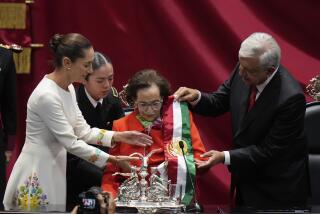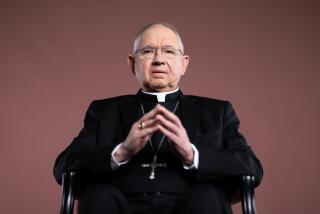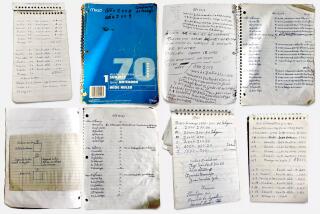Mother Teresa Reaffirms Ties in Her Fourth Visit to Tijuana
TIJUANA — On a street outside the crowded Tijuana municipal auditorium, Miguel and Esperanza Paredes and several of their 13 children were selling candy and snacks Thursday, as they have for 25 years.
But it wasn’t just any workday. Minutes earlier, the Paredes family had stopped and watched as a hunched figure in a shawl and blue sweater emerged from a car and was escorted into the auditorium amid a swirl of policemen, clergy and photographers.
“Mother Teresa,” said Esperanza Paredes, 65, who came to Tijuana 50 years ago from Mexico City. “She looks older now, poor thing. So many responsibilities, so much traveling around the world.”
It was the fourth visit to Tijuana for Mother Teresa, 81; the fourth time her charitable odyssey brought her back to a frontier between two nations whose socioeconomic disparity symbolizes her mission. The Nobel Prize winner’s religious order, the Missionaries of Charity, runs five religious communities in Tijuana.
As they do worldwide, the missionaries serve the sick, the poor, the old, the orphans. In Tijuana they have an additional concern: hundreds of impoverished migrants who arrive every day at a giant bus station a few miles from the U.S.-Mexico border. Many are hoping to make the perilous journey north. Many receive food and aid at Casa Beato Juan Diego, Mother Teresa’s center for migrants in the bleak, dusty landscape behind the bus station.
“She is someone very special to all migrants,” said Esperanza Paredes, who left her husband to supervise their vending tables while she went into the auditorium to watch an ordination ceremony for a priest and three deacons from the order’s seminary.
Mother Teresa’s choice of Tijuana as the last stop on a tour of her novitiates around the world had particular significance because Thursday was the feast day of the Virgin of Guadalupe, Mexico’s patron saint.
Fifteen-year-old Sergio Hernandez said people in his neighborhood, Colonia Libertad, and other residents of Tijuana feel a strong bond with Mother Teresa and her order.
“There is no one else like her,” said Hernandez, who sported slicked-back hair and cowboy boots. “It’s like the Pope was visiting.”
During a news conference at the seminary before the ceremony, Hernandez and several other youths cupped their hands to a window and watched from outside.
“Don’t ask me difficult questions or political questions,” a grinning Mother Teresa told a crowd of reporters in accented Engish.
But when the diminutive nun was asked about the plight of illegal immigrants in the United States she said: “They are our brothers and sisters. We must treat people as we wish to be treated. If heaven is our home, we are all only pilgrims on this earth.”
She then pronounced stern words against abortion, reasserted her conviction that women should not be ordained as priests, and appealed for better treatment of people suffering from AIDS.
“It is a beautiful thing that they have a place to die in the peace of God,” she said, describing the work of AIDS hospices that her order has established around the United States. “I ask you to pray to God that we can get a medicine to cure this disease.”
Appearing serene and even cheerful, Mother Teresa dismissed several questions about rumors that she is in fragile health.
“I am perfectly all right,” she said. “The whole world, all of our poor people, are praying for me, so I am all right.”
After exhorting her listeners, most of them from the Mexican press, to “always pray before you write so you can write something beautiful for the glory of God,” she brought the press conference to a distinctly unusual close. She led two dozen assembled journalists in a recitation of the “Hail Mary.”
More to Read
Sign up for Essential California
The most important California stories and recommendations in your inbox every morning.
You may occasionally receive promotional content from the Los Angeles Times.










